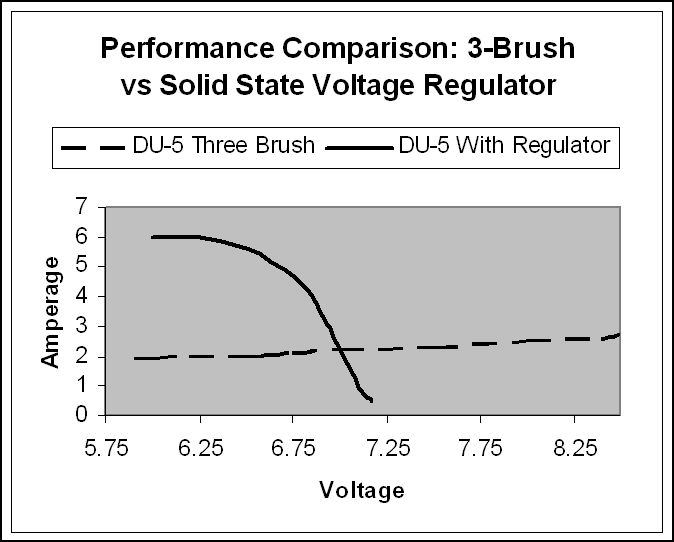SOLID STATE VOLTAGE REGULATOR OPERATION:
After installation of the solid state voltage regulator on a properly functioning three brush generator, the charging rate will be variable and automatic based on demand, and limited only by the design and condition of the generator. This will eliminate the problem of either overcharging or undercharging of the battery, and any guesswork needed when adjusting the third brush, regulator or cutout settings.
The solid state voltage regulator requires permanent removal of the third brush and the cutout relay. Minor wiring changes within the generator will convert the generator to a 2 brush configuration. The field winding circuit will be connected to the regulator, as will the battery and generator armature. This will allow the solid state voltage regulator to accurately control the voltage applied to the field windings, which will in turn control the current and voltage output of the generator. Based on the battery voltage, the generator will now charge only as much as needed. When the lights are on, generator output increases in an effort to maintain the desired battery voltage. When the lights are off, the charge rate tapers down as the desired battery voltage is quickly obtained, then a very small charge is applied to maintain the battery. If the battery is low, a high charge rate will be applied until the desired battery voltage is obtained, at which point the charge rate tapers down to a trickle charge. Depending on the condition and size of the battery and generator, it may take some time to reach a fully charged status.
The solid state voltage regulator will limit the maximum battery voltage to approximately 7.25 volts, but will adjust the generator current output up or down as needed to supply various loads in the electrical system. By accurately controlling the battery voltage and charge rate, undercharging, overcharging, overheating, and boiling of the battery is virtually eliminated. The result is longer battery life and reduced damage from battery acid vapors and leaks. This will also allow the use of gel type batteries which are very sensitive to overcharging and high voltage inputs.
No field adjustments can be made to the regulator. All settings are carefully pre- determined for each application and set prior to final assembly.
The original mechanical or electrical cutout relay is replaced by a high capacity diode within the circuitry of the regulator. The diode works as an electrical check valve, allowing power to flow out of the generator to the battery, but not in reverse. This eliminates the need to clean and adjust the contact points of the old cutout relay. It will also eliminate the possibility of the cutout sticking shut, which would drain the battery when the motor is shut off.
Normal operation of the regulator will by nature generate heat within the internal components. The electrical components must be kept cool to avoid damage. The regulator housing is designed as a heat sink, drawing heat away from the internal components. Higher output generators require larger heat sinks. It is normal for the regulator housing to get warm, even hot at times during operation.
